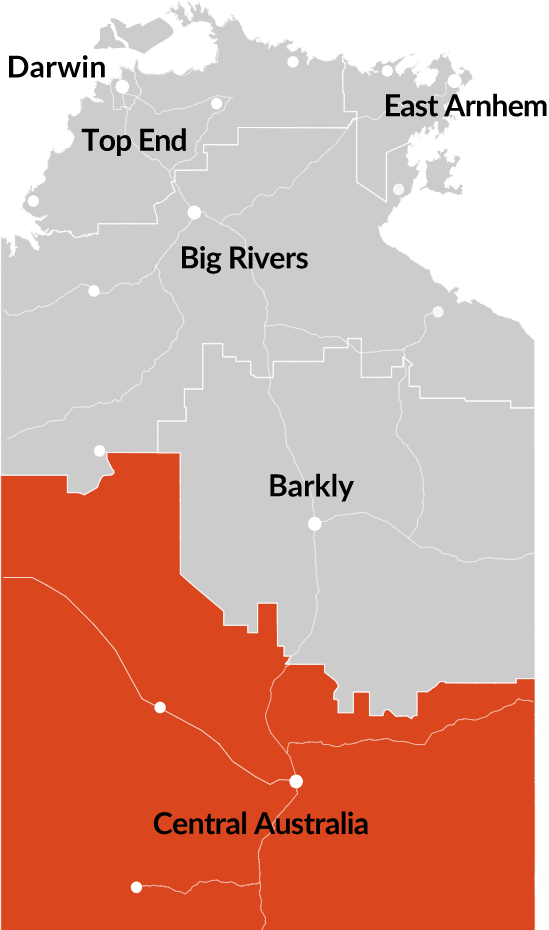Central Australia
The Central Australia region, located at the geographic centre of Australia, is mostly covered by desert land, spanning over 600,000 square kilometres, or 40% of the Northern Territory. The region contributes significantly to the NT economy.
The second largest town in the Northern Territory, Alice Springs, with a population of around 28,000, serves the total population of the region, which is about 41,000. Alice Springs is the major economic, business, and service hub of the region, and the economy mainly relies on mining, tourism, and primary industries. Government funding for regional service delivery and defence also plays a crucial role in sustaining the region’s economy.
A considerable number of people in the Central Australia region live in outlying communities, including the Yulara township, which provides lodging and services for the tourism industry at Uluru-Kata Tjuta National Park.
Other major remote centres in the Central Australia region include Ntaria, Yuendumu, and Papunya, while the rest of the population is widely dispersed across the region in smaller communities, outstations, pastoral properties, and mining operations. These residents rely on Alice Springs to access essential services and supplies.
The mining and energy resources sector is one of the main contributors to the gross regional product (GRP) of the Central Australia region, accounting for around 18%, which amounted to $2.9 billion in 2021-22. As well as being a significant player in the mining sector, the Central Australia region is also home to Desert Knowledge Australia’s Solar Centre in Alice Springs.
There are six mining projects in Central Australia with major project status, evidence of the region’s mineral exploration and development potential. Central Australia has a number of onshore energy projects in the region including the Mereenie oilfield, conventional gas at Amadeus Basin, Dingo and Mereenie gas fields and petroleum at the Amadeus Basin.

Minerals found in Central Australia
Which minerals are found in your home?
View the interactive map to find out
See more local stories from your region.
Activity in your region
Company: Newmont
Mine: Newmont Tanami
Mineral: Gold
Overview:
Newmont Tanami is a gold mine located in the remote Tanami Desert in the Northern Territory, almost 540 kilometres from Alice Springs and about 270 km from the nearest remote Aboriginal community of Yuendumu.
Newmont Corporation, the world’s largest gold mining company, has owned and operated the mine since 2002. Currently, the mine produces an average of 500 koz of gold each year. Newmont Tanami is an underground operation, and employs about 1200 people who fly-in, fly-out from locations including Darwin, Alice Springs, Perth and Brisbane.
Work on the Tanami Expansion project (TE2) is well underway, with expected completion in 2025. The main scope of the TE2 project involves the construction of a headframe and vertical hoisting shaft from a depth of 1,460m, which will be used for the transportation of ore and people from at depth in the mine to surface. This project will deliver significant ounce, cost and efficiency improvements and has the potential to extend the mine life beyond 2040.
Newmont Tanami is located on Aboriginal freehold land owned by the Warlpiri people, and managed on their behalf by the Central Desert Aboriginal Lands Trust, who have formal agreements in place with Newmont to share value and protect their land, heritage and culture. In addition, Newmont Tanami invest directly in initiatives that support community capacity-building activities, including traineeships and employment programs, scholarships, in-kind support and sponsorship grants.
Newmont Tanami also contributes millions of dollars annually to the Northern Territory economy through the employment of local citizens, the purchase of goods and services, payroll taxes, government royalties, land use payments, salaries and supporting community projects.
Community contribution:
- $108.4 million in taxes and royalties to the NT government in 2022.
- Supported 952 jobs and generated $239.3 million in economic value add in 2022.
- Suppliers and contractors in the NT supported an additional 360 jobs in 2022.
- Mine operations provided jobs, revenue, and economic activity to the region.
- Around 15% of the mine hires are indigenous.
- Supported the development of a local trucking company that provides transport services to the mine.
- Provided royalties to the local indigenous communities, which are used to fund essential services and community development projects.
- Provided healthcare services to local indigenous people, including access to doctors, nurses, and dentists.
- Funded a number of health promotion programs, such as smoking cessation programs and diabetes prevention programs.
- Funded cultural heritage projects such as the restoration of sacred sites and the creation of an indigenous cultural centre.
How many people are employed: 1,200
Mine lifetime: The mine is currently expanding and expected to operate for at least another 15 years.
Rehabilitation plan: There is an approved rehabilitation plan for the Newmont Tanami mine. The plan was developed in consultation with the Northern Territory government and the local Aboriginal community. The plan outlines how the mine will be rehabilitated after operations cease with the main objectives to:
- Restore the land to a condition similar to its natural state before mining began.
- Protect the environment and water resources.
- Provide opportunities for economic development and employment in the region.
- Potential for infrastructure reversion to the Warlpiri to support post mining land use development opportunities longer term.
- The rehabilitation plan is a comprehensive document that has been carefully developed to ensure that the mine is properly rehabilitated after operations cease. The plan is also regularly reviewed to ensure that it remains relevant and effective.
Company: Arafura Rare Earths Ltd
Project: Nolans Project
Mineral/Product: Rare earths neodymium and praseodymium (NdPr) as oxide
Overview:
Arafura Rare Earths is developing the Nolans Rare Earths Project 135 kilometres north of Alice Springs. The Project centres on one of the world’s largest undeveloped rare earths resources, particularly enriched in neodymium and praseodymium (NdPr) – critical minerals used in the production of permanent magnets for electric vehicles and renewable energy technologies including wind turbines.
The Nolans Project has a minimum 38-year mine life; it will employ more than 680 people during main construction, and more than 320 during steady state operations.
The Project will deliver extensive economic benefits to the broader Alice Springs region through employment, investment and spending, and the creation of opportunities for local businesses.
The project is construction ready, with all major Northern Territory permitting and environmental approvals in place. Enabling works and early construction activities commenced on site in mid-2023, and full construction is forecast to begin in the first half of 2024.
Arafura’s debt-led funding strategy for Nolans leverages the binding offtake agreements already in place with Hyundai and Kia, and Siemens Gamesa Renewable Energy.
The Nolans Project will significantly assist Australia in becoming one of the world’s next critical minerals powerhouses, delivering crucial NdPr oxide to global customers in alignment with the Federal Government’s Critical Minerals Strategy. In doing so, it will provide direct benefits to regional areas, create opportunities for First Nations peoples, deliver employment and training opportunities, and directly support the long-term economic prosperity of the Northern Territory.
Community contribution:
The Nolans Project will contribute:
- An average $580m to the Territory economy per year.
- An average $562m per year to the Alice Springs region.
- Almost $1.1 billion to the real incomes of residents in the Northern Territory over its operating life.
- The Nolans Project will pay an estimated $310.8 million in wages to Territory employees - $96.5 million to workers living in Alice Springs.
- The Northern Territory government will benefit from the Project through royalties, taxes and other economic activity.
- More than $152 million3 in payments to Indigenous groups including the Central Land Council:
- More than $122 million in NdPr royalties
- More than $29 million in other payments
- Generating significant economic benefits for Alice Springs, including increased employment, investment, and spending on top of opportunities for local businesses to supply goods and services to the mine.
- Creating significant community benefits, particularly for local Indigenous communities, such as jobs, training opportunities, and economic development opportunities for Indigenous communities.
- Social and cultural benefits to Indigenous communities have also been considered, with the project expected to provide improved access to health care, education, and other services.
How many people will be employed: More than 680 during main construction and more than 320 during steady-state operations.
Mine lifetime: Minimum 38 years.
Rehabilitation plan: A rehabilitation plan has been submitted to the Northern Territory government for approval. The plan includes measures to manage mine waste and process plant residues, as well as to progressively rehabilitate the site.
The comprehensive and detailed rehabilitation plan includes measures to ensure the site is returned to a safe and stable condition after the mine has closed, plus measures to protect the environment and to preserve cultural heritage values.
Company: Central Petroleum
Project: Amadeus Basin (Helium, hydrogen and hydrocarbons) Palm Valley, Dingo and Mereenie
Project: Central Australia and Barkly Region
Product: Helium, hydrogen and hydrocarbons, oil and gas
Overview:
Central Petroleum operates the largest onshore gas production fields in the Northern Territory (NT), supplying oil and gas from fields in Central Australia to NT customers and the east coast market.
Central Petroleum and its partners are currently investing in further exploration to secure greater supplies of gas for current and future customers.
The Amadeus Basin is also highly prospective for other valuable gases, such as helium and hydrogen, with a three well exploration program being planned and a helium recovery unit being considered for construction at the existing Mereenie gas field.
The key production area is the Amadeus Basin where oil and gas is produced from Mereenie, Palm Valley and Dingo fields.
Central Petroleum is focused on a multi-faceted growth strategy, including:
- Oil and gas production operations: Mereenie, Palm Valley and Dingo fields with 73 PJ of 2P gas reserves and 0.43 mmbbl of 2P oil reserves;
- Sub-salt exploration targets: three exploration wells are planned to be drilled in the Amadeus Basin, targeting helium, naturally occurring hydrogen and hydrocarbons;
- Near / in-field exploration targets: exploration targets in the Amadeus Basin targeting oil and gas from high-graded, drillable prospects; and
- Exploration opportunities: Almost 170,000 km² of tenements in under-explored hydrocarbon-bearing basins with enormous potential, including helium and hydrogen.
Overview
In 2023, Central Petroleum achieved the following deliverables:
- 40% of operational staff live in the Northern Territory
- 25% Indigenous personnel in NT
- Central paid over $2.6M of royalties and fees to the Northern Territory and Central Land Council in FY2023.
- Central and partners spent over $3.0M with local contractors and businesses in FY2023.
Project lifetime: 25 Years
